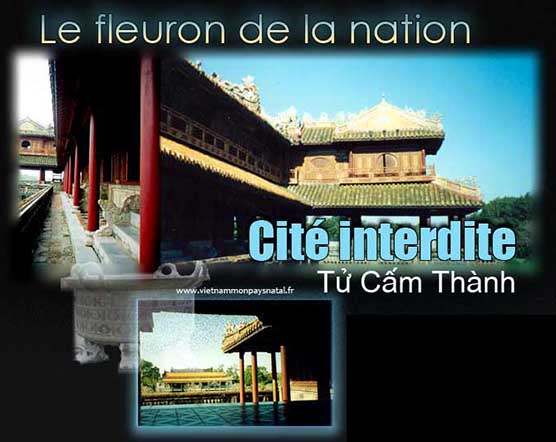Le fleuron Huế de la nation vietnamienne.
English version
French version
Galerie des photos
Tiền đồn của một vương quốc độc lập mang tên Chăm Pa lại trở về Việt Nam sau cuộc hôn nhân giữa công chúa Trần Huyền Trân và vua Chăm Jaya Simhavarman III vào năm 1306 và được đổi tên thành Huế. Thành phố từ đó trở thành một phần của đơn vị hành chính Thuận Hoá.
Sự biến đổi ngữ âm của từ Hoá đã mang lại cho nó cái tên Huế phổ biến từ thế kỷ 15. Huế sau đó trở thành trung tâm của sự bành trướng lãnh thổ về phía Nam, và kể từ năm 1801, với việc thống nhất đất nước của Hoàng đế Gia Long, Huế đã trở thành kinh đô của triều Nguyễn.
Vì vậy, qua nhiều năm, chúng ta có thể thấy sự đóng góp của viên ngọc quý này vào vương miện của nghệ thuật Việt Nam thông qua các cung điện và lăng tẩm
L‘ avant-poste d’un royaume indépendant dénommé Champa, redevint vietnamien après le mariage de la princesse Trần Huyền Trân et du roi cham Jaya Simhavarman III en 1306 et fut renommé Huế. Cette ville fit désormais partie de la division administrative de Thuận Hoá.
La déformation phonétique du mot Hoá lui donna le nom populaire de Huế dès le XVème siècle. Huế devint alors le point d’appui de l’expansion territoriale vers le Sud et depuis 1801, lors de l’unification du pays par l’empereur Gia Long, la capitale de la dynastie des Nguyễn.
C’est ainsi qu’on trouve, au fil des années, la contribution du fleuron Huế au trésor de l’art vietnamien à travers ses palais et ses mausolées impériaux.
The outpost of an independent kingdom called Champa became Vietnamese again after the marriage of Princess Trần Huyền Trân and the Cham king Jaya Simhavarman III in 1306 and was renamed Huế. This city then became part of the administrative division of Thuận Hoá.
The phonetic deformation of the word Hoá gave it the popular name Huế from the 15th century. Huế then became the stronghold for territorial expansion to the South and, since 1801, during the unification of the country by Emperor Gia Long, the capital of the Nguyễn dynasty.
Thus, over the years, the contribution of the jewel Huế to the treasure of Vietnamese art can be found through its palaces and imperial mausoleums.

